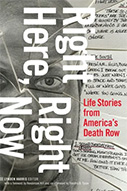Right Here, Right Now: Life Stories from America’s Death Row

Author: Lynden Harris
Publisher: Duke University Press, 2021. 268 pages.
Reviewer: AM Purdy | September 2022
The publication, Right Here, Right Now (RHRN), compiled and edited by Lynden Harris, was a thought-provoking and profound piece in its content and prose. RHRN is a compilation of stories told by men serving time under the sentence of death in the United States. The anonymous nature of this piece allows for these men to tell their stories without judgment or reproach, and it separates their lives from the highly publicized crimes that they committed. It is structured in a way to tell a story of a life that led to a sentence of death, and a life led while facing execution. While there are different authors voicing their tales throughout, it reads as one strong voice describing a story we hear time and again: that of a person who was failed by society leading up to and following the commission of the ultimate atrocity of taking another’s life.
RHRN begins with a foreword and introduction that set an unfortunately common scene in the United States – that of child abuse and neglect, drug use and violence, racial disparities and poverty, and a society that does not address these issues and instead funnels them through the school-to-prison-pipeline. Despite their trials and tribulations, they share words of hope and add their voices to a chorus of others who long to be heard. Harris warns the reader in the beginning that these “stories will surely break your heart,” which is indeed accomplished by pulling you through the lives that these men have lived, from birth to awaiting their death.
The childhood of these men is broken up into four significant parts, though it is arguable that many were unable to experience a childhood at all. The first is heartbreakingly entitled “The Part That Was Innocent,” restricted to the range of birth to five years old. The title alone provides a glimpse into the struggle that the rest of the authors’ lives will be. Prison was a part of their world for so many of these men from the beginning of their lives, having fathers, mothers, aunts, uncles, and more loved ones incarcerated. Prison was not an abnormality to these children, which is a luxury that many of us do not realize that we had while growing up. While many of our first memories revolve around making new friends, learning to play, or experiencing new things like the ocean for the first time, many of these men began their lives in hostile environments with their first memories being violent and terrifying. Though home should feel safe and comforting, it was often chaotic and dangerous to these storytellers. By the time they went to school, many of these men were put through more pain than some of us experience in a lifetime.
The next part is entitled “Boot Camp” and focuses on elementary school (six to ten years old). Once school began, it became clearer that addiction surrounded these men in many forms. From going hungry so that a parent could afford drugs, to being involved in the sale of drugs, to even trying substances for the first time – substance use and abuse was far from foreign to these children. As the title suggests, this is the time in which they were trained on how to survive. They learned how to hide drugs so that, when you were inevitably robbed, they would not be able to take it all. They learned to defend family and honor at whatever length, to push boundaries until others fear you. They learned the price for disobedience and that violence was the answer to many problems, and they learned that poverty begets poverty and that a lack of money can hold you back in the most selfish and unfair ways. They learned that their word meant nothing against someone who could afford to question it. They learned what death looked like – violent and raw, not the funeral home experience many of us had as an introduction to the concept of mortality. All of these things were learned in a rough and ruthless way before they were old enough to go to middle school.
The middle school years were still difficult, entitled “The Drama was Live” (ages eleven to thirteen). Here is where they started to learn what hopelessness felt like. Trying hard and being smart could not overcome poverty and difficult home lives. This is also the time where they began to understand that you do not ever talk about the horrible things you have seen, whether it was as a witness to drug deals, mangling, or murder. Many were forced into roles as the “man of the house,” or caretaker, to those who should have been caring for them. Coping and defense mechanisms often manifested as some sort of self-harm or recklessness. Mental health was something to be ignored and repressed, not discussed and treated. Sacrifices had to be made at the cost of their childhoods. They learned that there was no such thing as equality and that they were born into situations that made hope for the future seem inane.
Perhaps that is why the next section, “From Bad to Worse,” only gives them the age of fourteen to their arrest. The fact that this section is what brings them out of childhood is telling. Many fourteen-year-olds are experiencing problems no worse than puberty and schooling, with their greatest concerns being acne, friends, and tests. These men were experiencing far worse trials than many of us could imagine at that age. They experienced the deaths of good friends and abuse by the systems that were meant to care for them. School was not a reprieve from a difficult life, and many lost the opportunity to continue attending due to circumstances outside of their control. Juvenile detention centers were often places of abuse and racial discrimination and had little to no focus on education or rehabilitation. These institutions that should have been focused on helping these teenagers who had clearly lived difficult lives; yet, instead, they exacerbated the problems and pushed them toward becoming tough and ruthless as a means of protection.
Once they crossed the line that they could never uncross, they were brought into a system that had given up on them before they ever existed. In “Given the Circumstances (Jail to Trial and Sentencing),” the book moves on to discuss the early experiences of being incarcerated in a system rife with violence, racism, and rampant abuse of power. Suicidal ideation was met with solitary confinement instead of treatment. This all prior to conviction for a capital crime. Once convicted, the chapter “Worst of the Worst (Entering Death Row and Solitary),” details the difficulties of adjusting to life on death row. One intriguing shift they experience is that from a world of fighting for survival to one of simply living to see the next day. For some of these men, this is where they experienced acts of kindness without expectations of reciprocation for the first time, despite those performing these acts being deemed the “worst of the worst.” Details of the poor conditions of the cells they found themselves in, from roaches to mice to unbearable stench, also stood out in their discussions. The situation is meant to tear them down and contain them, and used to reduce any ounce of comfort that they could otherwise find.
This is further evidenced in the next chapter, “You Are Not Here to be Rehabilitated (Life on Death Row).” In this section, they detail the difficulties in maintaining connections to the outside world, tied with the desire to have some sort of mental escape from their imprisonment. Reading their efforts to connect through letters, or through a glass window, further shows how easy it is to take human connection for granted. Many have gone years without physical affection, and never get to see their children or meet their grandchildren. Those loved ones who put in the effort to maintain a connection with the death-sentenced inmate are treated as guilty themselves and must jump through hoops just to keep in contact. The emphasis that they were not there to be rehabilitated, but instead were there to serve their time until death, did not stop these men from building connections in which they could find the smallest things to bring them and others joy. Some stories shared in this book will stay with me forever – the shock of not seeing the sun except through small windows, only being able to place one phone call a year, and finding joy by taking care of stray cats, just to have the windows covered in plexiglass to prevent those cats from returning, are all a part of the lives these men lead.
Finally, in “Every Day’s Worth Celebrating (Facing Execution),” these men who have lived without hope for most of their lives provide surprisingly positive and hopeful stories. Among the stories of being on death watch – watching friends die, facing eminent death, and having little to no control over their environments – there were tales of living for the moment, as well as embracing and finding joy in the things that you do have. This is a surprisingly hope-filled conclusion to the stories that the men share.
When an inmate is sentenced to die at the hands of the state in the United States, it is often a highly publicized case, with media coverage following from the commission of the crimes throughout the duration of the trial. Following sentence and incarceration, this coverage tapers off and we as a public are not kept aware of the conditions in which these people are kept. Reading the stories that these men share works more toward humanizing a population that all too frequently is left in the dark, sometimes literally. Life under sentence of death is not a pleasant one to lead. Frequently, inmates are housed in a solitary cell, with little to no contact with others. There is little to do in the way of passing time. As Johnson, Reiter, Kupers, Ridgeway, and so many others have articulated in their respective pieces, constant solitary confinement is a detriment to the human psyche and physical well-being of an inmate.
This piece furthers our understanding of not only experiences when sentenced to death, but also the tenacity that a human can hold to still be able to grow, learn, and think deeply despite the conditions that they are living under. The authors in Right Here, Right Now chose to write about their past far more frequently than their present. What this does is give us a window into the lives that occurred before life behind bars. It shows a life that is full of thoughts, feelings, and emotions and opens the eyes of the world up to the fact that the experiences of those under sentence of death are all too similar, and all too human. If any lesson is to be taken from Right Here, Right Now it is that life is not an experience of black and white or good and evil. There are complexities that make us human, and these complexities are present even in those we incarcerate and sentence to death.
References
Harris, L. (2021). Right here, right now. Duke University Press.
Johnson, R. (2019). Condemned to die: Life under sentence of death. Routledge.
Kupers, T.A. (2017). Solitary: The inside story of supermax isolation and how we can abolish it. University of California Press.
Reiter, K. (2016). 23/7: Pelican Bay prison and the rise of long-term solitary confinement. Yale University Press.
Ridgeway, J., Casella, J., & Shroud, S. (Eds.). (2014). Hell is a very small place: Voices from solitary confinement. The New Press.
AM Purdy is an Adjunct Instructor and Doctoral Candidate at American University.


